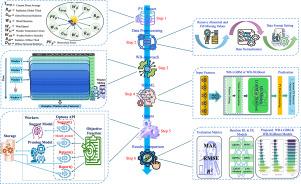WBML-PV: Window-based machine learning for ultra-short-term photovoltaic power forecasting
IF 1.8
Q3 AUTOMATION & CONTROL SYSTEMS
引用次数: 0
Abstract
Accurate ultra-short-term photovoltaic (PV) power forecasting is essential for grid management and the integration of renewable energy. However, the stochastic and volatile nature of PV power, along with inherent uncertainty, challenges stable grid operation as PV penetration grows. Currently, deep learning (DL) and reinforcement learning (RL) models often struggle to generalize under new conditions, manage computational demands, and address the uncertainty in PV forecasting. To address these issues, a window-based machine learning (WBML) approach is proposed, utilizing light gradient boosting machine (WB-LGBM) and extreme gradient boosting (WB-XGBoost) models. These proposed models outperform attention-based and non-attention-based RL and DL baselines in deterministic metrics like mean absolute error (MAE) and , while significantly reducing training time. Optimized via Optuna and evaluated using fuzzy C-means clustering, their performance is validated by the Diebold–Mariano test. Uncertainty is assessed using non-parametric kernel density estimation (NPKDE) and confidence intervals (CIs) at 99%, 95%, 90%, and 80% confidence levels within the WBML framework, demonstrating robust and conservative forecast uncertainty quantification. Amplitude and phase errors are analyzed with standard deviation error, bias, dispersion, skewness, and kurtosis. The models demonstrate reduced imbalance penalties and enhanced revenue through improved forecasting accuracy.

WBML-PV:基于窗口的超短期光伏功率预测机器学习
准确的超短期光伏发电功率预测对于电网管理和可再生能源并网至关重要。然而,随着光伏发电的普及,光伏发电的随机性和波动性以及其固有的不确定性给电网的稳定运行带来了挑战。目前,深度学习(DL)和强化学习(RL)模型往往难以在新条件下进行泛化,管理计算需求,并解决PV预测中的不确定性。为了解决这些问题,提出了一种基于窗口的机器学习(WBML)方法,利用光梯度增强机(WB-LGBM)和极端梯度增强(WB-XGBoost)模型。这些模型在平均绝对误差(MAE)和R2等确定性指标上优于基于注意和非基于注意的RL和DL基线,同时显著减少了训练时间。通过Optuna进行优化,使用模糊c均值聚类进行评价,并通过Diebold-Mariano检验验证了其性能。在WBML框架内,使用非参数核密度估计(NPKDE)和99%、95%、90%和80%置信水平的置信区间(ci)评估不确定性,展示了稳健和保守的预测不确定性量化。振幅和相位误差用标准差误差、偏置、色散、偏度和峰度进行分析。该模型表明,通过提高预测精度,减少了不平衡惩罚并增加了收入。
本文章由计算机程序翻译,如有差异,请以英文原文为准。
求助全文
约1分钟内获得全文
求助全文
来源期刊

IFAC Journal of Systems and Control
AUTOMATION & CONTROL SYSTEMS-
CiteScore
3.70
自引率
5.30%
发文量
17
 求助内容:
求助内容: 应助结果提醒方式:
应助结果提醒方式:


